Hakka-Style Halibut
I’d like to raise a virtual glass of bubbly to Linda Lau Anusasananan, whom I’ve known for years since her days as the recipe editor for Sunset magazine.
I’d like to congratulate her on a job well done for finally publishing her “The Hakka Cookbook: Chinese Soul Food from Around the World” (University of California Press), of which I recently received a review copy.
It’s a true labor of love and deliciousness that Lau Anusasananan spent more than five years working on. Her brother, artist Alan Lau, did the lovely illustrations of ingredients in the book.
For Chinese-Americans like myself, we’re all the better for its publication, too, because it includes so many recipes for dishes that we grew up with and still crave to this day.
The Hakka once lived in the plains of the Yellow River near Henan in north-central China, Lau Anusasananan writes. Because of war, famine, droughts and floods, they were forced to migrate south to become minorities without a true home. Because they were landless, they were looked at disparagingly. Often, after being shunned, they would have to pull up stakes and start over on land no one else wanted, usually infertile spots in the remote highlands.
I’m not sure if my family has Hakka roots, though they do hail from southern China. But the dishes in this book definitely speak to me with their strong, rustic flavors. Lau Anusasananan calls Hakka cuisine “nomadic soul food.” It’s home-cooking. It’s comfort food. It’s dishes such as “Steamed Chicken and Chinese Sausage,” “Stir-Fried Cumin Beef,” “Steamed Pork Hash” and “Salt-Baked Chicken.”
As well as “Pan-Fried Fish, Green Onions and Chiles,” which you might know better from Chinese restaurants as salt-and-pepper fish. It’s a seasoned salt-and-pepper mixture used often in restaurants on fried pork riblets, too.
This dish couldn’t be simpler. It’s just halibut chunks wok-tossed after being coated with white pepper, cornstarch, salt and five-spice powder. The latter — a mixture of star anise, cloves, cinnamon, Sichuan pepper and fennel seeds — is like magic fairy dust, enveloping the palate in cozy warmth.
One taste had me smiling over memories of enjoying this exact taste with my family at so many restaurant gatherings in San Francisco.
I miss those times, as my parents are no longer with me. So, thank you, Linda, for providing me a way of recapturing those beloved tastes in my own kitchen now.
Meet Linda Lau Anusasananan: She’ll be signing copies of her cookbook at Eastwind Books in Berkeley, 2:30 p.m.-4:30 p.m. Oct. 21. She’ll also be signing copies at Omnivore Books in San Francisco, 6 p.m.-7 p.m. Oct. 24. Both events are free.
Pan-Fried Fish, Green Onions, and Chiles
(Serves 2 to 3 as a main dish or 4 to 6 as part of a multicourse meal)
For the fish:
1 pound skinless fillet from a firm, white-fleshed fish, such as halibut
1/2 teaspoon salt
1/8 teaspoon five-spice powder
1/8 teaspoon ground white pepper
2 tablespoons cornstarch, or as needed
2 tablespoons vegetable oil
For the stir-fry:
1 tablespoon vegetable oil
3 green onions, cut into 3-inch lengths, including green tops
12 thin slices ginger
5 to 8 thin rings from fresh chile (preferably red), such as Fresno or jalapeno, or to taste
1/8 teaspoon salt, or to taste
1/8 teaspoon five-spice powder
For the fish: Rinse fish and pat dry. Cut fish into sticks 1/2 inch thick and 2 to 3 inches long. On a large plate, mix the salt, five-spice powder, and white pepper. Coat fish with salt mixture. Shortly before frying, sprinkle the cornstarch over the fish to lightly coat; shake off excess.
Set a 12-inch nonstick frying pan over medium-high heat. When the pan is hot, after about 1 minute, add oil and rotate pan to spread. Place fish in a single layer in the pan and cook, turning once, until the fish is browned on the outside and barely opaque in the center of the thickest part (cut to test), 4 to 5 minutes total. With a slotted spatula, transfer fish to a serving dish.
For the stir-fry: Return pan to medium-high heat. When pan is hot, add oil and rotate to spread. Add green onions, ginger, chile, salt and five-spice powder. Stir-fry until green onions begin to wilt, about 30 seconds. Return fish to the pan and stir-fry gently until seasonings coat the fish, about 30 seconds. Transfer to a serving dish.
From “The Hakka Cookbook: Chinese Soul Food from Around the World” by Linda Lau Anusasananan
More Chinese Comfort Food: Andrea Nguyen’s Roast Chicken with Red Fermented Tofu
And: My Mom’s Chicken and Rice
And: My Version of Steamed Pork Hash

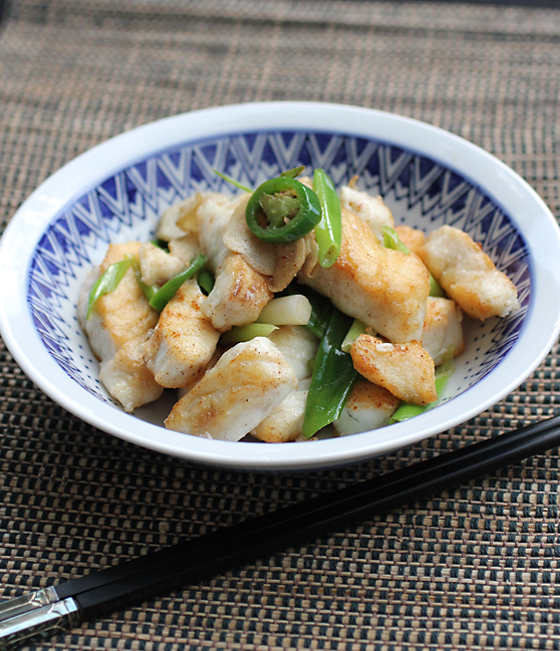
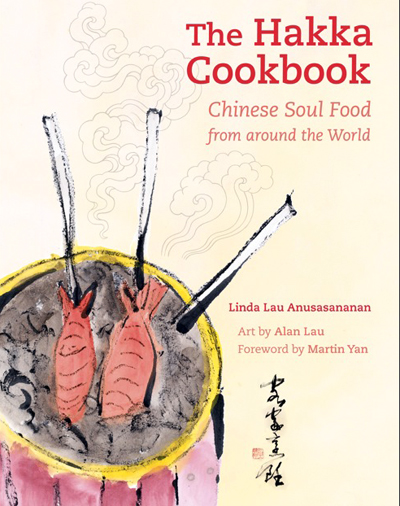
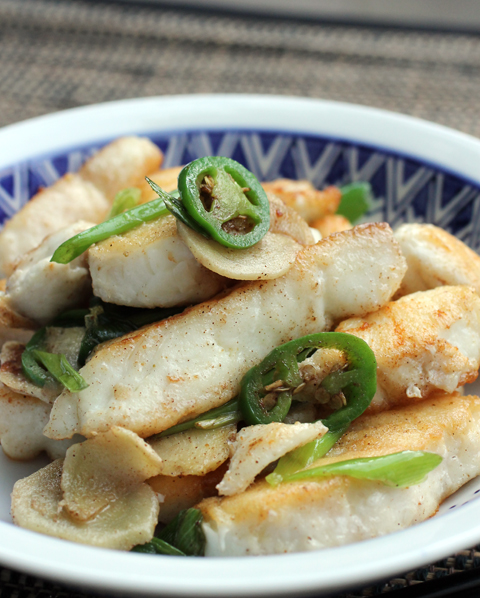
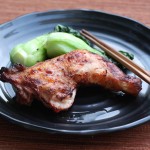
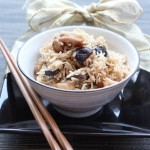
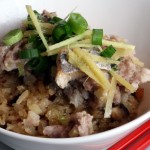
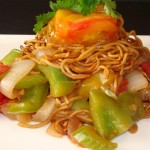

A delicious way of preparing this fish! I love the addition of five spice powder.
Cheers,
Rosa
I love fish and could probably eat it at least four or five times a week. This recipe looks like it is going to be a must try! It just looks so delicious.
The recipe looks wonderful, and I love the cookbook cover!
Wow, I really admired the author of the book, even though I don’t know her personally. But 5 years of dedication to create a cookbook, she definitely won my respect. I love rustic and simple home cooking. This Hakka Style Halibut looks and sounds scrumptious! Definitely my type of comfort food. 🙂
Mmmm, you did an expert job in browning that halibut. Looks so golden brown. I haven’t eaten much Hakka food. I think it’s really hard to find because Hakka food isn’t the type of food considered refined enough to serve at restaurants. So unless you’re invited to a Hakka family, you really don’t get to understand what the food is all about. Nice to see a book like this to educate people’s palate to this.
Wow, simply beautiful! Perfect meal for a chilly fall day. 🙂
That’s easy enough to do. I might just try it since I haven’t had much Hakka cuisine in SF.
This is the kind of food I can have every day, seriously. Just give me steamed rice or a bowl of rice porridge to go with it, with some stir-fry greens; and I call that meal, comfort. Well, I am Chinese, after all. I am not as familiar with Hakka cuisine as Hokkien or Teochew cuisine. I would really like to try some good authentic home-style Hakka food some day.
What a wonderful cookbook and a real family effort too! 😀 Nothing comforts me like Chinese food 🙂
I so much love tasty recipes as this one! That’s my style of cooking & surely eating!
this actually sounds quite tasty, even to this fish-hater. the slices of ginger are neat. 🙂
“Nomadic soul food” – what a great description of a cultural food. Sounds quite interesting and definitely a cookbook to be checked out. Thanks for this review. It was interesting how you were able to relate so much to the food.
Wow, this is such a simple dish and looks so great. And I know someone who’s a frequent guest at my house who’d like this. Definitely something I’m adding to my big list of stuff to make! Thanks for this.
Carolyn, Thanks for such a lovely review. I did write The Hakka Cookbook especially for people like you and me, Chinese Americans, who wanted to know more about their roots through food. What better way to remember your heritage through recipes from your childhood. In our multicultural society, it is so easy to lose your culinary roots. My book was my way to help preserve some of our history, stories, and recipes for the next generation.
Hi Carolyn!
What a great book – My family is Hakka (settled in Vietnam) and I am home with my family this weekend. My mom just made steamed chicken with sausage tonight =). Can’t wait to check out this cookbook to see how it compares to my mom’s dishes!
Pingback: Gluten Free Links #10 – October
Pingback: Recent kudos for The Hakka Cookbook | The Hakka CookbookThe Hakka Cookbook
Just made this and it is so simple and delicious! Thanks for the inspiration.
Jennifer: I’m so glad you love this dish as much as I do. It’s definitely a keeper!
This looks ABSOLUTELY stunning! I’d love that for dinner tonight!
I’ve read Linda’s Hakka Cookbook a handful of times now. I love her writing, her story, and her recipes. I’ve made a few Hakka dishes for my blog, and I plan on cooking more.
The Hakka Cookbook had opened my eyes and broaden my Hakka knowledge. I feel so proud to be a Hakka.
-Kayiu
Saucy Spatula, NYC
Kayiu: I love this cookbook. It has so many favorite dishes that I enjoyed as a kid. Tasting them is like being in my Mom’s kitchen again.